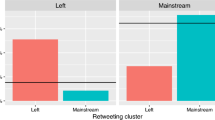Abstract
Where machine learning and other quantitative methods have been used for classification purposes in helping researchers manually identify extremist Twitter accounts, they have chiefly been used to classify far-right and ISIS/Jihadi accounts. There are no large-scale quantitative studies of far-left (specifically Antifa) accounts. Since the election of Donald Trump as the 45th President of the USA, there has been a rise in public acts of violence, vandalism, de-platforming and harassment of political speakers by Antifa. Twitter plays an important role in helping Antifa to organise, radicalise individuals, harass other users and share propaganda. This paper attempts to provide a classification of Antifa accounts based on network mapping and textual clues. We found that approximately 1.1% (644) of Antifa sympathetic accounts can be classified as Cognitive Extremists. Violent Extremists (313) accounted for 0.5% (313) of all Antifa sympathetic accounts. However, members of that group had an average following of 5370 followers compared to an average of 3804 for Cognitive Extremists and 707 for all Twitter users, indicating widespread support from extreme and violent action from all three categories of Antifa accounts.







Similar content being viewed by others
References
ADL (2019) Who are the Antifa? Retrieved from https://www.adl.org/resources/backgrounders/who-are-the-antifa
Alva S, Frau-Meigs D, Hassan G (2017) Youth and Violent Extremism on Social Media: Mapping the Research. UNESCO, Paris
Anti-fascist network (2015) How to set up an anti-fascist group. Retrieved from https://antifascistnetwork.org/how-to-set-up-an-anti-fascist-group/
Baron U (2018) Rising tides on left and right: How dangerous are right and left- wing extremism? [Live Stream]. Mind the Gap: Radicalization and De-Radicalization in Theory and Practice. Konrad adenauer stiftung expert conference, Berlin, Germany. Retrieved from https://www.kas.de/veranstaltungen/detail/-/content/mind-the-gap
Berger J (2016) Nazis vs. ISIS on Twitter: a comparative study of white nationalist and ISIS online social media networks. GW Program on Extremism. Retrieved from https:// extremism.gwu.edu/sites/g/files/zaxdzs2191/f/downloads/
Berger J (2018) Extremism. MIT Press, Cambridge, MA
Berger J, Perez H (2016) The Islamic States diminishing returns on Twitter. GW Program on Extremism. Retrieved from https://cchs.gwu.edu/sites/g/files/zaxdzs2371/f/ downloads/Berger_Occasional%20Paper.pdf
Berger J, Morgan J (2015) The ISIS twitter census: defining and describing the population of isis supporters on twitter. The brookings project on US relations with the Islamic World [Analysis Paper]. Retrieved from https://www.brookings.edu/wp-content/ uploads/2016/06/isis_twitter_census_berger_morgan.pdf
Birchall S (2010) Beating the Fascists: The untold story of anti-fascist action. Freedom Press, London
Bray M (2017) Antifa: the Anti-fascist Handbook. Melville House Publishing, Brooklyn, NY
Bundesamt für Vefassungsschutz (2015) Left Wing Politically Motivated Offences. Retrieved from https://www.verfassungsschutz.de/en/fields-of-work/left-wing-extremism/figures-and-facts-left-wing-extremism/left-wing-politically-motivated-offences-2015
Burris SK (2017) WATCH: white nationalist Richard Spencer sucker-punched in the face during Trump inauguration. Raw Story [News Article]. Retrieved from https://www.rawstory.com/2017/01/watch-white-nationalist-richard-spencer-sucker-punched-in- the-face-during-trump-inauguration/
Ferrara E, Wang WQ, Varol O, Flammini A, Galstyan A (2016) Predicting online extremism, content adopters, and interaction reciprocity. Retrieved from https://arxiv.org/ abs/1605.00659
Full list of Antifa Members (2017) 8chan. Retrieved from https://8ch.net/pol/ res/10404804.html#10405484
G20: Hamburg police seek help to find 'Black Bloc' riot activists (2017) DW. Retrieved from https://p.dw.com/p/2pY9
Glaser M (2013) Linke” Militanz im Jugendalter - ein umstrittenes Phänomen. In: Schultens R and Glaser M (Eds.) “Linke” Militanz im Jugendalter: Befunde zu einem umstrittenen Phänomen. Deutsches Jugendinstitut e.V., pp. 4–21
Hartung M, Klinger R, Schmidtke F, Vogel L (2017) Identifying Right-wing extremism in german twitter profiles: a classification approach. In: Frascinar F, Ittoo A, Nguyen LM, Métais E (Eds). Natural language processing and information systems: 22nd international conference on applications of natural language to information systems (NLDB 2017). Lecture notes in computer science. Vol 10260. Springer International Publishing, (pp. 320–325)
Haunss S (2013) Die Autonomen - eine soziale Bewegung zwischen radikaler Gesellschaftskritik und Subjektivismus. In: Schultens R and Glaser M (Eds.) “Linke” Militanz im Jugendalter: Befunde zu einem umstrittenen Phänomen. Deutsches Jugendinstitut e.V., pp. 26–46
It’s Going Down (2017) Forming an Antifa Group: a manual. Retrieved from https:// itsgoingdown.org/forming-an-antifa-group-a-manual/
Oreskes B, St John P (2017) After 'Antifa' violence, Berkeley debates whether Milo Yiannopoulos and other conservatives are welcome. The Los Angeles Times. Retrieved from https://www.latimes.com/local/lanow/la-me-berkeley-far-left- protests-milo-20170830-story.html
Schuhmacher N (2013) Sich wehren, etwas machen - Antift-Gruppen und -Szenen als Einstiegs- und Lernfeld im Prozess der Politisierung. In: Schultens R and Glaser M (Eds.) “Linke” Militanz im Jugendalter: Befunde zu einem umstrittenen Phänomen. Deutsches Jugendinstitut e.V., pp. 47–70
Selk A (2018) Antifa protestors couldn’t find any fascists at Unite the Right - and harassed the press instead. The Washington Post. Retrieved from https://www.washingtonpost.com/news/local/wp/2018/08/13/antifa-protesters-couldnt-find-any- fascists-at-unite-the-right-and-harassed-the-press-instead/?utm_term=.05e230f97895
Testa M (2015) Militant anti-fascism: A hundred years of resistance. AK Press, Oakland, CA
Victor D (2017) Amateur Sleuths aim to identify charlottesville marchers, but sometimes misfire. The New York Times. Retrieved from https://www.nytimes.com/2017/08/14/us/charlottesville-doxxing.html
Wei Y, Sing L, Marting S (2016) Identification of extremism on twitter. In: International conference on advances in social networks analysis and mining (ASONAM), San Francisco, CA, pp. 1251–1255
Author information
Authors and Affiliations
Corresponding author
Additional information
Publisher's Note
Springer Nature remains neutral with regard to jurisdictional claims in published maps and institutional affiliations.
Rights and permissions
About this article
Cite this article
Lenihan, E. A classification of Antifa Twitter accounts based on social network mapping and linguistic analysis. Soc. Netw. Anal. Min. 12, 12 (2022). https://doi.org/10.1007/s13278-021-00847-8
Received:
Accepted:
Published:
DOI: https://doi.org/10.1007/s13278-021-00847-8




